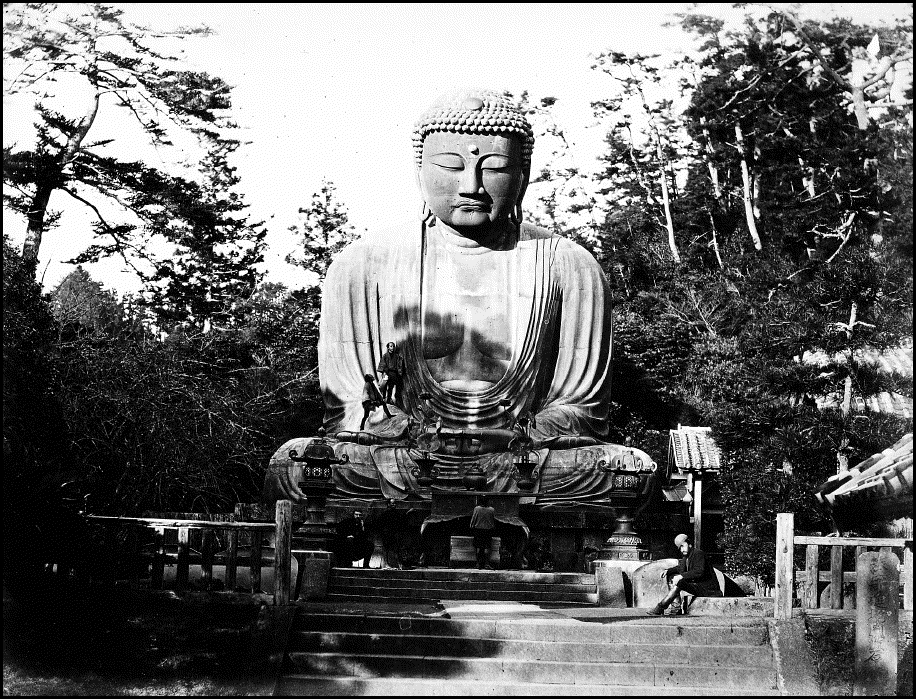
Felice Beato
A Photographer on
The Eastern Road
Anne Lacoste
Fred Ritchin, Editors
(Getty Museum)

Between 1852 and the turn of the century, Felice Beato traveled throughout the British Empire to record colonial wars, exotic peoples, and panoramas. His missions included the Crimean War, the Indian Mutiny of 1857 (the first War of Independence), the Second Opium War ... and, finally, the American Invasion of Korea (1871).From his travels through India, China, Japan, Burma and Egypt, Beato took intimate shots of the bearers of Japan, coolies of China, the Kachins and Priests of Burma, bathers in Irrawaddy, the so-called "Japanese Hercules" along with koto and shamisan musicians ... and Korean chieftans.
The panoramas --- often five to seven feet long --- include Sikh Temples, the Muchee Bhawan Fort in Lucknow, the Sacred Well of Benares, the Great Imperial Porcelain Palace in Pekin, and elevated views of Yokohama, the Hakone Pass, and the Atango Yama temple of Yedo.
Of the 120 plates printed lavishly (and beautifully) here, the most interesting are the hand-tinted photographs from the streets of Edo Japan (Beato maintained a studio in Tokyo for twenty years), and historical shots of Nagasaki, Pekin, Lucknow, Delhi, and Amritsar.
Much is made in this volume of the presence, in many of the photographs, of "natives" in appropriate attire, which is seen as a function if not a factor of colonialism. It was probably simpler than that: Beato wanted to give some idea of the scale of the buildings, forts, and temples that he was recording. By sprinkling people around, he could give a feeling for the grandiosity of, for example, the Kyoung at Mandalay or the temple at Hatchiman. In a few, he even set up the camera, uncovered the lens, and ran around and sat down for a few moments to record himself for posterity.
In many of these, there is a feeling of spaciousness or, better stated, emptiness. Which probably has to do with the technology of this earliest equipment for producing albumen glass plate negatives. Several minutes were necessary for exposure, which meant that taking photographs of people moving through these scenes would probably make them invisible. Thus could one disappear when one was being recorded for posterity.
§ § § This leads us to Beato's second great theme, at least as suggested in A Photographer on the Eastern Road. It consists of pictures of destroyed forts, buildings, roads ... along with the dead of war. Before this, battle had to be recorded in etching, drawing, or on canvas. But if you were a photographer in the early experimental phase of the photographic art --- after the mid-nineteenth century --- and wanted to invoke the drama of the dead of war, you could either pose people around your exotic war locales, or you could find scenes there where people would not be moving around too much. These would be of particular interest to those who were far from the killing fields, back home, paying for their foreign adventures, much as we do now.
We find here forty plates dedicated to the colonial wars. There is a portrait of a dual hanging at Lucknow. There is a confusion of bodies at North Tuku Fort (both of these came about due to the Second Opium War). A dozen or so bodies are scattered about in various stages of disrepair at Fort McKee (in Korea). An earlier photograph from the Indian Uprising, taken at the Secundra Bagh in Lucknow, shows a liberal littering of rib-cages, thighbones, jaws, and skulls.
These, reports the editor, may have come from the "slaughter of the 2,000 rebels by the 93rd Highlanders and 4th Punjabi Regt," but these dry bones may have been RIP elsewhere. It is reported that Beato and his assistants brought them out from behind the fortress walls and sprinkled them about judiciously, in the courtyard, then took the shots ex post facto.
Ms. Lacoste discusses at some length whether such staging is legitimate, asking whether this turns war-photography into "theatre," but to this reviewer, the dead are dead and might as well be caught somehow. If you have to pick up bones and litter them about in a new locale, so be it. Or as Curzio Malaparte reported it, after a sizable battle in Italy,"There are only twelve ambulances left in the whole of Naples. The rest have been sent to Rome, where they don't need them. Poor Naples! Two raids a day, and we haven't even got ambulances. Thousands of people have been killed today: as always, the working-class districts are the worst hit. But what can I do with twelve ambulances? We need a thousand."
I said to him: "Requisition a few thousand bicycles. The injured can go to a hospital on bicycles, can't they?"
"Yes, but what about the dead? The injured can go to a hospital on bicycles, but what about the dead?" said the engineer.
"The dead can go on foot," I said, "and if they don't want to walk kick them in the ass. Don't you agree?"
The engineer looked at me strangely, and said: "You're trying to be funny. I'm not. But it will end as you say. We shall only get the dead to the cemetery if we kick them there."
"They deserve it. They're a real nuisance, the dead. Always corpses, more corpses, and still more corpses! Corpses everywhere! For three years we've seen nothing but corpses in the streets of Naples. And what airs they give themselves --- as if they were the only people in the world! Let them lay off, once and for all! Otherwise, boot them to the cemetery and to hell with it."
--- C. A. Amantea